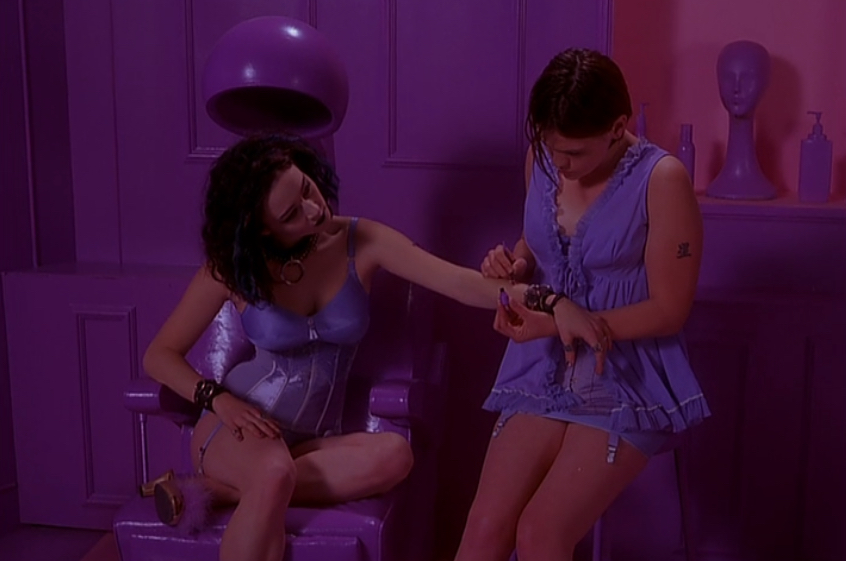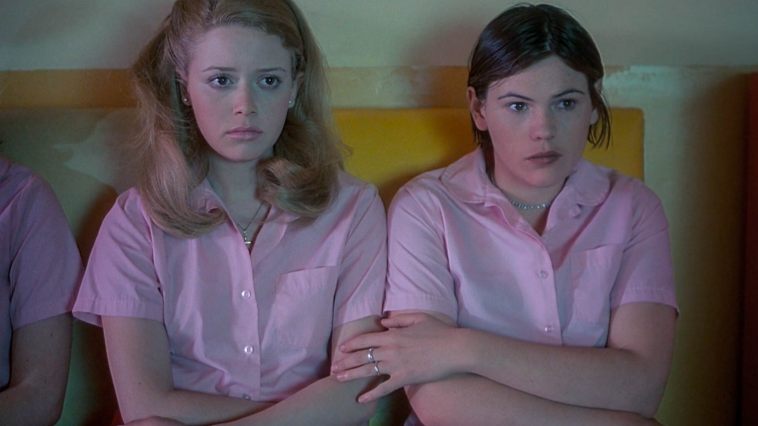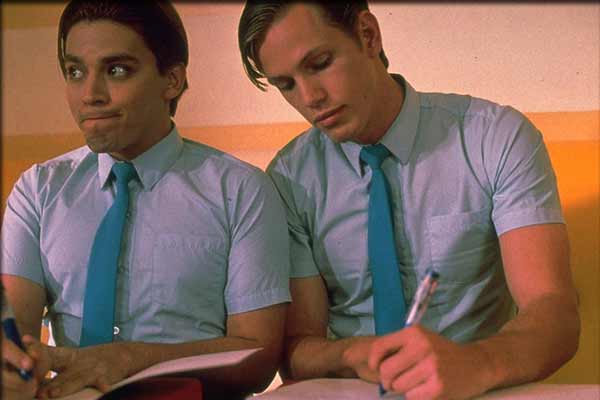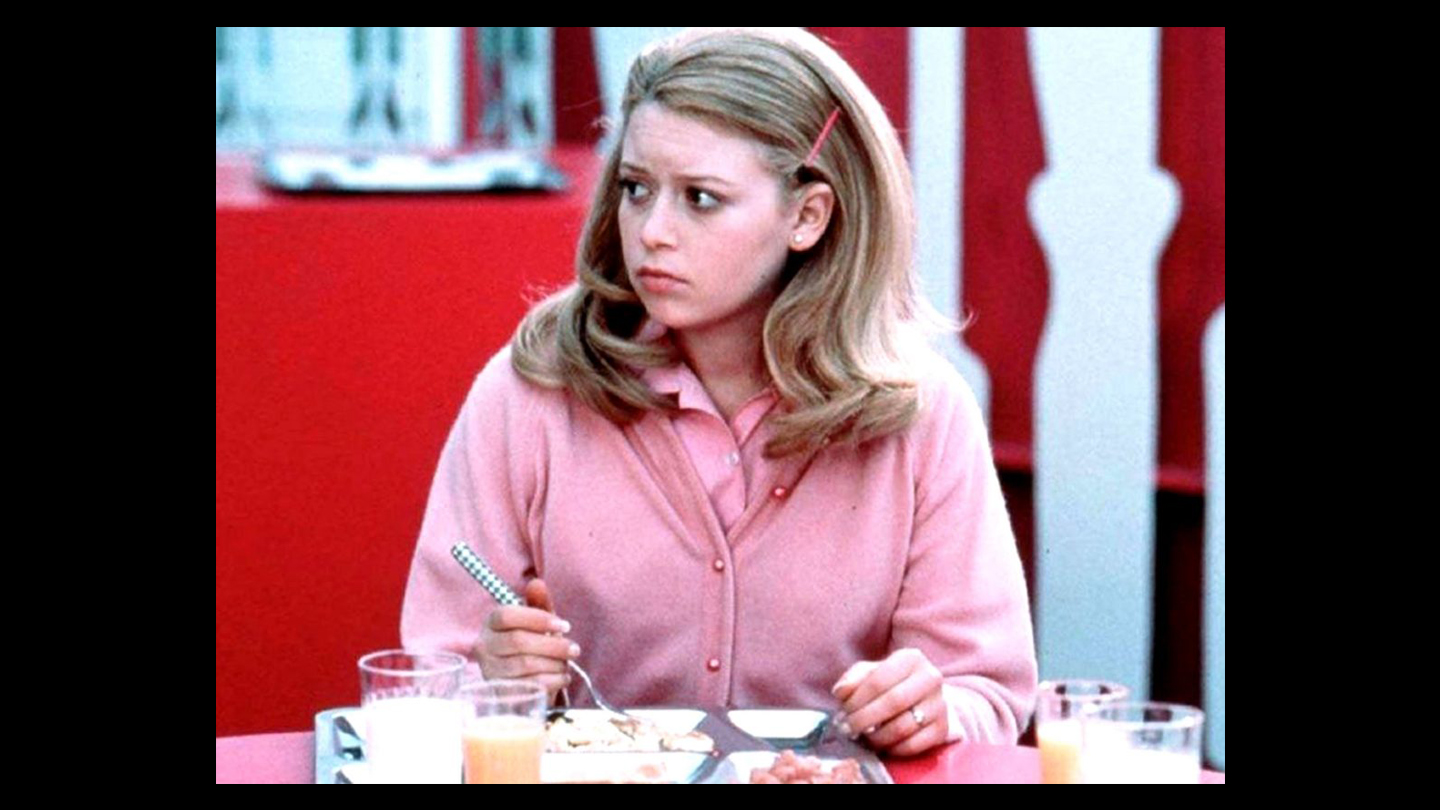It’s a running joke that all queer cinema ends in misery. Everyone knows the drill by now: every single LGBT+ movie in existence inevitably ends in the following ways: untimely death, vicious murder, a lifetime in the closet, total ostracism or being alone forever.
“When I was 25, every gay movie that I saw was really depressing,” laughs director Jamie Babbit, who has worked on films like Itty Bitty Titty Committee and episodes of The L Word and Russian Doll. Twenty years ago her career as a feature film director began with But I’m A Cheerleader — a garish, satirical first in the bleak canon of queer film. “I wanted to tell a joyful, happy ending lesbian story that was funny,” she says. And in the decades following, the film — which stars Natasha Lyonne and Clea DuVall — has become a cult favourite.
But I’m A Cheerleader follows Megan, a teenager who prefers eyeing up her fellow cheerleaders to French kissing her beige boyfriend. As her religious parents stack up the evidence — their daughter is a Georgia O’Keefe-loving vegetarian with a bedroom filled with “vaginal motifs” — an intervention is staged, and she’s swiftly sent off to gay conversion camp.

In reality, gay conversion therapy is a gravely serious matter. Recent films like Boy Erased and The Miseducation of Cameron Post (the latter which directly references But I’m A Cheerleader; both end with their lead characters escaping in a pick-up truck) tackle the subject by taking a sombre approach. Meanwhile, Jamie Babbit and screenwriter Brian Wayne Peterson encourage us to laugh in the face of cruelty. There’s power found in ripping evil to shreds with humour.
Some reviewers felt that the film relied heavily on stereotypes — missing the fact that it was really a film about breaking them down. Jamie Babbit relished the response. “When I went to Sundance and got an F in Entertainment Weekly , I knew I had touched a cultural firestorm if I was eliciting such negative reviews from men,” she says. “I really took it as a badge of pride.”
From the very beginning, But I’m A Cheerleader’s own conversion camp is a shambles: lead ex-gay counsellor Mike (played by a plainclothes RuPaul Charles) spends his day trying to repress his drooling over the headmistress’ son Rock (Eddie Cibrian). The rehab sets out to convert the campers, but ironically Megan (Natasha Lyonne) falls in love with fellow camper Graham (Clea DuVall) and realises that being a cheerleader and liking girls isn’t mutually exclusive.
Steering away from the mandatory disaster of many other LGBT+ films, But I’m A Cheerleader ends with a post-credits scene which spells out Happily Ever After: Megan’s dad, Peter (Bud Cort), speaking at a meeting for the Parents & Friends of Lesbians and Gays. “I wanted to show that there’s a journey ahead for them too,” Jamie says. “I liked that Megan’s mother was there in disguise.”
Casting But I’m A Cheerleader initially proved difficult: an unnamed actress once turned down the lead role of Megan because she couldn’t face the prospect of her family spotting her on a poster for a lesbian movie. However, after weeding out those unwilling to be associated with an LGBTQ project, the film found a phenomenal cast.

“I had made a short right before But I’m A Cheerleader called Sleeping Beauties, which starred Clea DuVall,” Jamie recalls. “She worked in a coffee shop I used to go to and she’d give me free drinks. I wrote the part of Graham for her and she knew Natasha from auditioning around town. I was so lucky Clea gave her the script. I loved Natasha, and I thought she was completely cast against type. When I met her she was wearing fishnet stockings, a leather mini-skirt and giant, curled-out hair. I knew she was nothing like a midwestern cheerleader, but I also knew she was a really talented comedian and actress.”
Wesley Mann and Richard Moll also joined the cast as ex ex-gays Larry and Lloyd Morgan-Gordan, while John Waters regular Mink Stole plays Megan’s mother. The film also stars Joel Michaely, Douglas Spain, Kip Pardue and Melanie Lynskey, all in their early twenties at the time and starting out together in Hollywood.
“I asked Jamie, ‘Why do you want me to play him?’” remembers Dante Basco, who played But I’m A Cheerleader’s gay varsity wrestler Dolph. “Jamie said to me: ‘The thing about Dolph is that he’s the boy next door, and Dante, you’re the boy next door.’ The brilliance of Jamie is that she’s able to see past my ethnicity. An Asian character with two lines in a movie is not a full person. For her to understand how the world really is — it’s not just a white world — was really important. She’s exactly the kind of director I wanted to work with.”
Jamie Babbit was also inspired by her own childhood when constructing the film. Having grown up in Shaker Heights, a tree-speckled suburb of Cleveland, Ohio, her mother ran a drugs and alcohol rehab centre for teenagers called New Directions. Being around a rehab facility from a young age informed the basic premise of But I’m A Cheerleader.

“Both my mom’s parents were alcoholics,” Jamies says. “I found so much irony in my mum being so freaked out by drugs and alcohol, and yet completely surrounded by people who were obsessed with them. And she chose that life for herself! I thought, if a woman started a gay conversion camp, there must be something there that’s so anti-nature.”
Loosely inspired by Jamie’s mother, True Directions’ headmistress, Mary Brown (played by a perfectly terrifying Cathy Moriarty), is a total germaphobe with a love of putting things into boxes. The flowers that surround her bright pink Barbie house are plastic and the sky is a painted backdrop. But despite her efforts to create somewhere sterile, nature keeps creeping back into the picture. The cardboard trees lining her garden are absurdly phallic, and everyday objects become suggestive emblems: to the delight of the boys, True Directions’ resident gardener Rock strokes broom handles and revs chainsaws around the grounds.
“RuPaul was our straight coach and we were these teenage boys trying to become straight by chopping wood and running around trying to be guys,” Dante laughs . “The irony was super comical. During a montage scene, they were shooting me and Kip Pardue, Joel Michaely and Doug Spain listening to RuPaul talk. He was going off on a monologue about really explicit sexual things off-screen; it was so hard to keep a straight face. The outtakes of him schooling us on being gay off camera were hilarious.”
Filmed in the sleepy town of Palmdale, California, the entire cast also became a tight-knit gang. “We were all still kids,” says Dante. “When we got out there in the cuts, all we had was each other. We would do suburban teenage stuff like go to the mall and eat at Applebee’s together.
“I don’t know how many of the other cast members know this,” Dante continues, “but me and Kip [Pardue] felt that we should kiss on screen for the first time,” referring to his on-screen relationship with Clayton Dunn. “We ended up asking one of the actresses — who I won’t name — to help us out. We had a kissing make-out rehearsal back in the trailers. It was like a fraternity, But I’m A Cheerleader, and you rooted for everyone in it,” he adds.
“There was a lot of horsing around on set,” Jamie remembers. “The worst offender was Cathy Moriarty. There’s a scene where Natasha says ‘I’m a lesbian! I’m a homo!’ — the scene where she finally admits it — and she’s drooling. You can see Cathy Moriarty in the wide shot laughing. I just had to live with Cathy Moriarty smirking in the background,” she laughs, “hoping no-one would notice.”
But I’m A Cheerleader was created with a teen audience firmly in mind, but once complete, the US’ ratings board stamped the film with an adult-only NC-17. After several revisions, the rating was eventually changed to R.
“I had to shorten Megan’s masturbation scene, and cut a line of Hilary’s where she says ‘Did you go down on Megan?’” Jamie explains. “They don’t like female masturbation and they don’t like any reference to oral sex between women.” And looking at the straight teen movies released that time — in the R-Rated American Pie, the lead character graphically masturbates with a hot apple pie — there’s a disparity. “Those double standards really pissed me off,” she agrees. “I had RuPaul say the line: ‘Who wants to go down with me?’ The boys all raise their hands, and the rating board didn’t have any problem with that. It was definitely sexism and I pointed that out.”
The ratings board also took issue with Graham and Megan’s sex scene, while Jamie herself also totally forgot to raise the topic of nudity ahead of filming. “I was a young director so I didn’t realise that you had to talk months in advance with actors,” she recalls. And when the two actors declined, she was left with a crisis on her hands. “I was scrambling to make the sex scene sexy, without any nudity. The costumes they were wearing were those pink nightgowns which seemed like they were for grandmas. I was concerned it would look stupid. Basically, I had the idea to shoot it very dark with hot spots of light.”
The ratings board later highlighted the scene as a point of concern. “They said, ‘We can tell in that dark sex scene that there’s a lot of things happening,’ she laughs. “I know there’s nothing happening, except grandma costumes!”
Jamie says that she knew that the film would be one of those that queer people passed to each other on bootleg DEVS. “Now it’s also all over the internet,” she adds. “I met a teacher in Saudi Arabia and she tells me it’s very popular in her circles. The movie has gotten out.”
20 years on from its release, But I’m a Cheerleader continues to spread by word of mouth. Though we’ve seen a new wave of LGBTQ cinema in recent years — teen films like Love, Simon, Giant Little Ones and Alex Strangelove resist leaning on the tragedy trope — But I’m A Cheerleader was an early outlier with a definitively happy ending.
Even now, two decades on, Dante says he still gets approached by fans of the film. “Gay teenagers often let me know that But I’m A Cheerleader played a pivotal part in them coming out to their parents,” he says. He’s proud of the project. “It’s time to tell the whole story. Films like Crazy Rich Asians and Moonlight represent a new era of representation. But I’m A Cheerleader is also part of that.”
And meanwhile, Jamie Babbit’s been musing on what became of Megan and Graham after their soppy departure into the sunset. “I think Megan would be living in New York and working as a college coach for a cheerleading team,” she reckons. “Graham would be living in San Francisco running a coffee shop. I don’t think they stay together, but I think that’s ok. It was first love!
“Anyway,” she adds, “I don’t necessarily think you should always fall in love with the person you’re with at gay rehab when you’re a teenager.”
